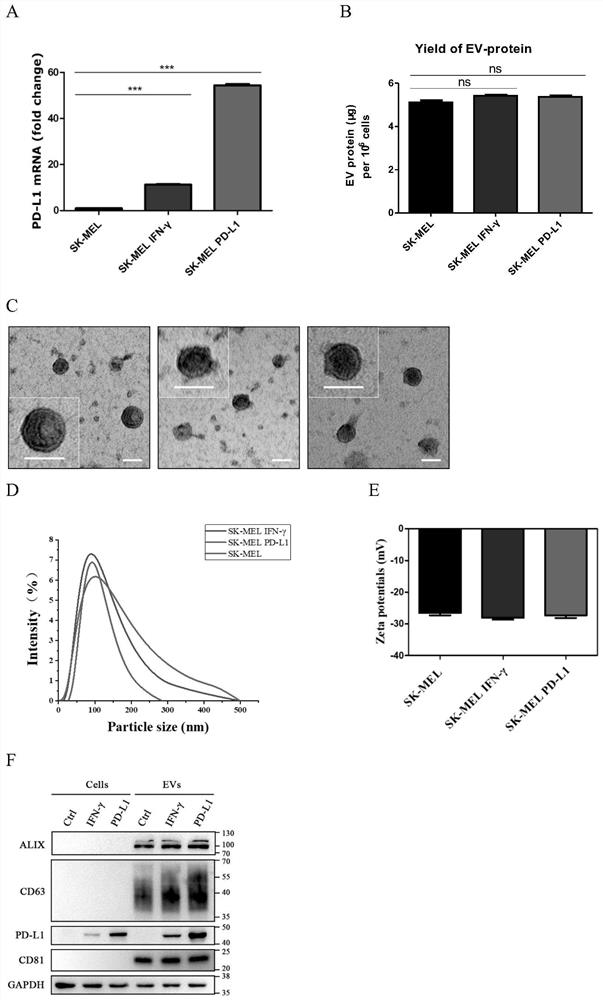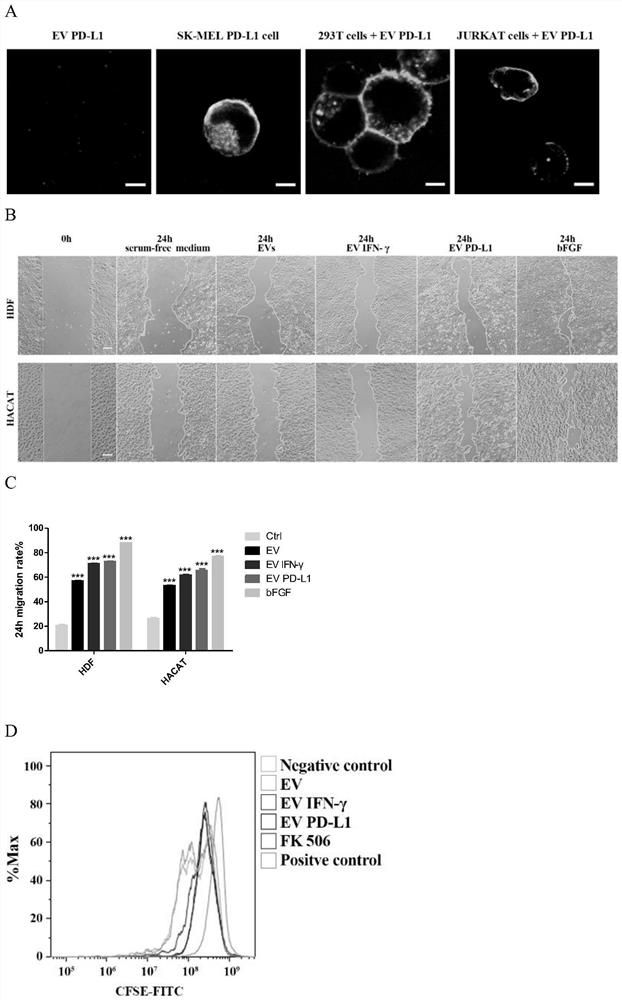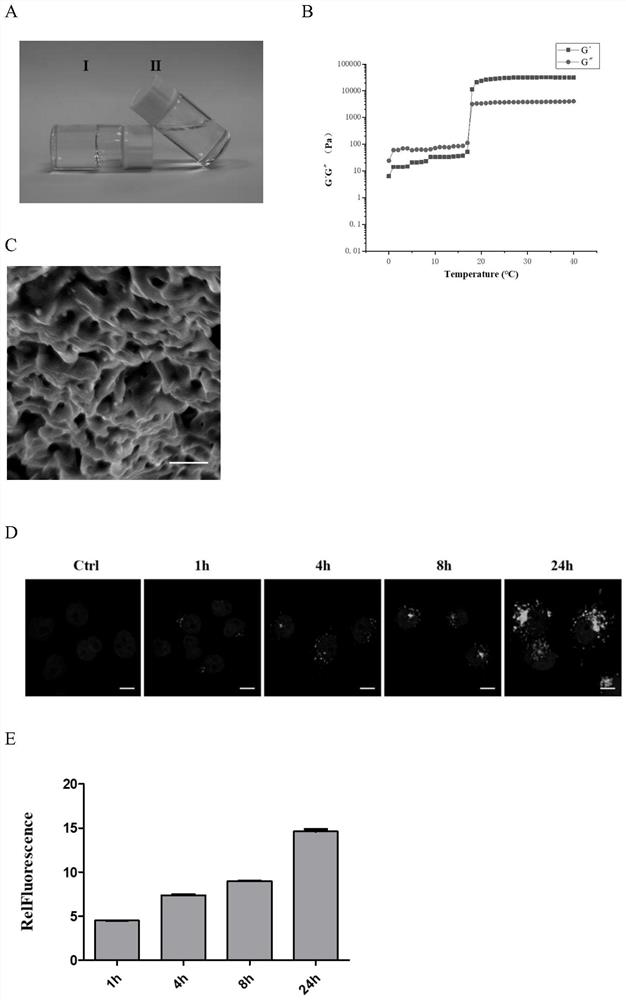New application of PD-L1 exosome
A PD-L1, 1. PD-L1 technology, applied in the field of biomedicine, can solve the problems of exosomal PD-L1 use that has not been reported, and achieve the effect of inhibiting excessive immune response, promoting wound shrinkage, and great application prospects
- Summary
- Abstract
- Description
- Claims
- Application Information
AI Technical Summary
Problems solved by technology
Method used
Image
Examples
Embodiment 1
[0053] Example 1 Extraction, detection and characterization of PD-L1 exosomes
[0054] 1. Extract the total RNA from SK-MEL cells, IFN-γ-stimulated SK-MEL cells and SK-MEL cells stably expressing PD-L1 after infection, and use PrimeScript RT-PCR Kit (TaKaRa) for reverse transcription experiments to obtain cDNA. The transcription level of PD-L1, that is, the change of the mRNA level of PD-L1, was detected by fluorescent quantitative method. Among them, the fluorescent quantitative PCR detection uses β-actin as the internal reference gene;
[0055] The PCR primer sequence of the internal reference gene of β-actin detected by fluorescence quantitative PCR is:
[0056] Forward primer F: 5'-CTCCATCCTGGCCTCGCTGT-3';
[0057] Reverse primer R: 5'-GCTGTCACCTTCACCGTTCC-3';
[0058] The primers for detecting the transcription level of PD-L1 by fluorescent quantitative PCR are:
[0059] Forward primer F: 5'-TCCACTCAATGCCTCAAT-3';
[0060] Reverse primer R: 5'-GAAGACCTCACAGACTCAA-3'...
Embodiment 2
[0066] Example 2 Functional detection of PD-L1 exosomes at the cellular level
[0067] The exosomes suspended in PBS were stained with the dye CY5.5, the excess dye was removed by centrifugation with a 50KD ultrafiltration tube, the slides were fixed on a cell shaker, and then the exosomes were added. Use a slide machine to spin the slices, 1500xg, 15min, let the cells attach to the glass slide, take out the excess liquid with filter paper, seal the slices, and take pictures under the laser confocal microscope for observation. Infect SK-MEL cells with the PD-L1 plasmid carrying OFP, and after screening out the SK-MEL cells stably expressing PD-L1, the cell membrane was stained with the dye WGA488. After 15 minutes, the cells were fixed with 4% paraformaldehyde and carried out The slides were sealed and photographed under a confocal laser microscope, which confirmed that SK-MEL cells with high expression of PD-L1 had been successfully prepared. Infect 293T cells with the PD-1 ...
Embodiment 3
[0070] Example 3 Preparation and characterization of thermosensitive gel embedded with PD-L1 exosomes
[0071] Weigh PF-127 (Sigma-Aldrich) powder, add water to dissolve, stir at 4 ° C for 1 h, and prepare a 20% thermosensitive hydrogel, which can become a gel state (like solid state) at room temperature, and at 4 ° C capable of becoming a flow state, such as image 3 As shown in A, the hydrogel in I has solidified at room temperature and cannot flow, and II shows that the hydrogel just taken out of the refrigerator at 4 °C still has flow properties.
[0072] Viscosity and elasticity of 20% PF-127 temperature-sensitive hydrogel in the range of 0-40°C were measured by rotational rheometer. The heating rate is 5° C. / min, the strain amplitude is 1%, and the frequency is 0.159 Hz. The result is as image 3 As shown in B, when the temperature is lower than 17°C, G' (elastic modulus) G", the system Approximate to solid colloid.
[0073] Pre-cool 20% PF-127 temperature-sensitive...
PUM
 Login to View More
Login to View More Abstract
Description
Claims
Application Information
 Login to View More
Login to View More - R&D
- Intellectual Property
- Life Sciences
- Materials
- Tech Scout
- Unparalleled Data Quality
- Higher Quality Content
- 60% Fewer Hallucinations
Browse by: Latest US Patents, China's latest patents, Technical Efficacy Thesaurus, Application Domain, Technology Topic, Popular Technical Reports.
© 2025 PatSnap. All rights reserved.Legal|Privacy policy|Modern Slavery Act Transparency Statement|Sitemap|About US| Contact US: help@patsnap.com



